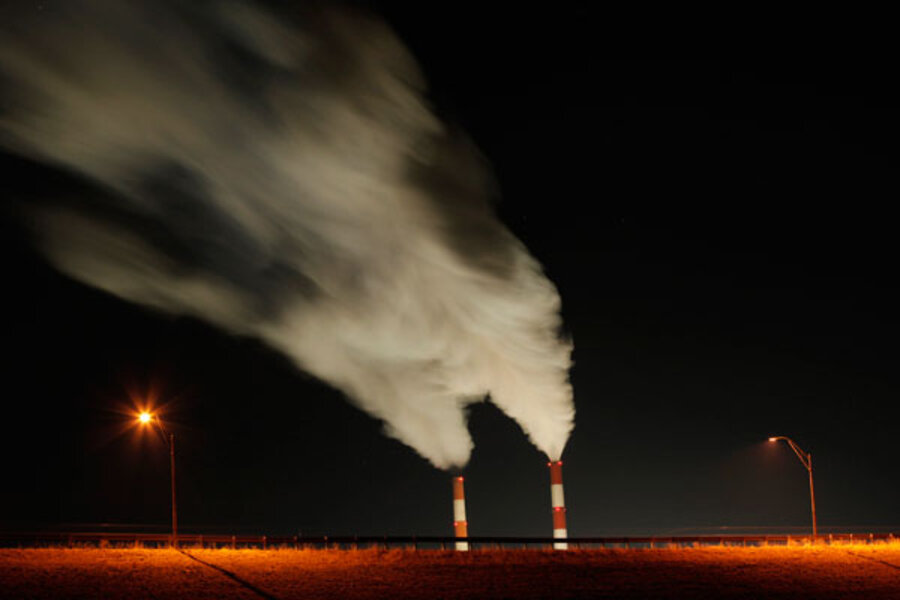Obama to unveil climate change plan with sweeping emissions cuts
Loading...
Recognizing that Congress is unlikely to pass significant climate change legislation during his second term, President Obama will take some of the most sweeping measures available to him to unilaterally combat global warming.
The new plan, which Mr. Obama will unveil Tuesday at Georgetown University, is expected to include a ramping up of energy efficiency and renewable energy in addition to national preparations to deal with the meteorological and financial impacts of climate change. But by far the strongest element of the plan is a set of new regulations intended to slash greenhouse-gas emissions from existing coal-fired power plants – not just power plants built in the future.
Obama intends to issue a presidential memorandum directing the Environmental Protection Agency to implement new regulation of greenhouse-gas emissions under the authority of the Clean Air Act. The president's plan is an attempt to deliver on his promise to cut carbon emissions 17 percent below 2005 levels by 2020, White House officials told reporters in a conference call Monday.
The move has the potential to cut annually hundreds of millions of tons of carbon dioxide (CO2) – a potent greenhouse gas – and far overshadow any carbon-emissions cuts the Obama administration has achieved so far through improved fuel-efficiency standards. But it could also accelerate the closure of many existing older coal-fired power plants across the country, which are already struggling to meet current standards.
"Nothing on this scale in the Clean Air Act has ever been attempted before," says Kevin Book, an energy analyst with ClearView Partners, an energy economics consulting firm in Washington. "This step will be the catalyst for the next wave of coal-fired power plant retirements. It's almost certainly going to get hung up in the courts for years."
Obama seeks to combat global warming in a variety of ways in the new plan. Among the highlights:
- Create new energy-efficiency standards for federal buildings and appliances.
- Ramp up enough clean-energy production on public lands to power 6 million homes by 2020.
- Extend $8 billion in loan-guarantee authority to accelerate investment in advanced fossil-energy and efficiency projects.
- End public financing of coal-fired plants overseas and push for free trade in clean-energy technologies.
But a concrete plan to reach a 17 percent cut in carbon emissions is seen as the cornerstone of Obama's move. That figure is widely considered a requirement for the US to be taken seriously in ongoing international climate talks. Obama wants to reinvigorate US efforts to lead in those talks, White House officials said.
They said the plan to address existing-power-plant emissions has a firm timeline – adding credibility to the effort. The goal is to finalize power plant emissions regulations by June 2015, long enough before Mr. Obama leaves office to be solidly in force before the next administration takes over.
"We know that we have to get to work quickly in order to not only propose, but finalize the rule," said a senior White House official. "The president will be directing the EPA to start that work."
Neither the briefing for reporters nor the fact sheet and background materials provided by the White House presented an estimate for the tonnage of carbon emissions expected to be cut overall. Electricity-generating power plants emit about 2.4 billion tons of CO2 each year, roughly 40 percent of the nation’s total emissions. But the plan was still received enthusiastically by environmentalists.
"If this means a launch to begin [emissions] cuts to existing power plants, we’ll be very pleased. It’s everything we’ve been asking for,” says David Doniger, climate policy director for the Natural Resources Defense Council in Washington.
Lack of details on exactly how much tonnage of carbon emissions is expected to be cut is not a problem at this point, he and others say.
“It seems they’re not ready to say exactly what they’re going to propose,” Mr. Doniger says. “But if they are willing to commit to [regulating] existing power plants, then that’s the core of it. That’s what we’ve been asking for. If there’s a deadline now, then that’s them carrying out the Clean Air Act the way it’s supposed to work....”
Coal-industry groups said the plan was misguided and would come at an enormous cost.
“We do not believe EPA regulations are an effective way to address concerns about global climate change,” said Robert Duncan, president and CEO of the American Coalition for Clean Coal Electricity. “If EPA proceeds with regulations, they should be based on adequately demonstrated technology and provide an achievable timeframe to allow the coal industry to continue advancing clean coal technologies.
The past several years have not been kind to the coal industry, given the low cost of natural gas and the development of clean energy.
In the first half of last year, for example, 165 new power generators were added in 33 states, but among the 10 states with the bulk of new generating capacity, "most of the new capacity uses natural gas or renewable energy," the Energy Department's Energy Information Administration (EIA) reported.
The trend is expected to continue, with natural gas-fired plants accounting for 60 percent of capacity additions between 2011 and 2035, EIA found. Coal is expected to account for 7 percent.
Utilities have shuttered about 12 percent of the nation’s coal-fired generating fleet since 2010, according to M.J. Bradley & Associates, an environmental consulting firm in Concord, Mass. Most, the study said, are "small, old, and lack advanced pollution control equipment."
These trends led to a 13.1 percent falloff in CO2 pollution from coal-fired electric power plants between 2005 and 2012, according to a recent analysis of EIA data by the Environmental Integrity Project, a Washington-based environmental group.
But the first quarter of 2013 has seen a 7.1 percent increase in CO2 emissions from coal compared with the same period last year as natural gas prices rose, encouraging more use of coal, according to the analysis. Global warming emissions from coal-based electricity are projected to rise 8.7 percent this year, though they are not expected to return to the peak levels of five to 10 years ago, the EIA has projected.
New regulations directed at existing plants could turn that trend, with many more coal-fired plants shuttered – including even newer plants that cannot meet the new standards, energy experts say.
Still, the Obama administration says cutting carbon pollution will help modernize power plants, spark innovation to create new clean-energy technologies, and put Americans to work. Greater energy efficiency will save American families money, officials add.
Moreover, they point to the rising costs from extreme weather events, which many scientists say can be amplified by the effects of global warming. Last year alone, 11 different weather and climate disaster events incurred estimated losses of more than $1 billion each across the nation. Those events together resulted in over $110 billion in estimated damages, the second-costliest year on record.
“We don’t have to choose between cutting carbon pollution to protect the health of our kids and creating jobs,” a senior administration official told reporters. “Americans know that we can do both.”








